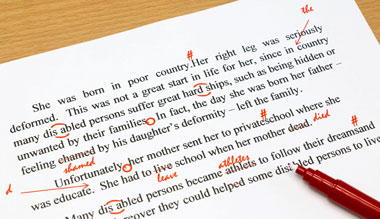 You’ve spent weeks writing, designing, and editing a fantastic piece that you’re about to release to print. WAIT! Have you given it one last proofread?
You’ve spent weeks writing, designing, and editing a fantastic piece that you’re about to release to print. WAIT! Have you given it one last proofread?
Often times, a copy document will undergo rounds of revisions before it makes it to layout, then rounds more of revisions after design. During this process, a file will pass through multiple sets of hands, including writers, designers, account managers, and directors. And that is all before the files are prepped and packaged for print!
In all of those exchanges, there are countless opportunities for change.
Grammatical and content changes should be reviewed and copyedited thoroughly by the core team members or writers on the project. But what about the final proofread?
Your designers will run a number of design and production checks on the design file before releasing the project to print. As for copy, here is our list of top quality and consistency checks to run:
Casing
Are you using title casing, sentence casing, or something else in your headlines? Do you reference certain terms that require upper casing? Whichever you choose, just make sure you’re consistent throughout the piece.
Bullet Points
Bullet point punctuation should be consistent throughout the list, but not necessarily from list to list. That depends on whether or not you’re completing an introductory stem. This article concisely summarizes phrase vs. list punctuation differences.
Copy Flow
If a document is going through review after layout and it’s decided that more copy is going to be added in any given area, designers need to be diligent about ensuring the copy is reflowed well. This means that text boxes are readjusted so that the copy fits the page well, and line breaks are adjusted as to not leave orphans or ragged breaks.
References
If copy is added or cut, citations need to be reviewed thoroughly to confirm that the numbering and page references have not changed. This also goes for the Table of Contents and table or image references.
Oxford Comma (Serial Comma)
Does your team use the Oxford comma (the comma used after the penultimate item in a list of three or more items)? While the rules around using it or not may be unclear, you should be clear on whether or not you use it consistently.
Phone Numbers and Addresses
Arguably one of the most important pieces of information on your piece is your contact information. It’s easy to glaze over this information in your review because you may feel as though you’ve seen it a million times. But if you take 3 extra seconds to review any one part of your piece, it should be verifying your contact information.
In addition, how are you punctuating your numbers and addresses? Phone numbers can use dashes, periods, parentheses, and any combination. Addresses may include building or floor references.
Examples
609.963.4004 vs. (609) 963-4004
71 North Main St., 1st Floor vs. 71 N. Main Street, First Floor
URLs
Similar to phone numbers and addresses, URLs should be a top priority in your review. Test casing and slugs by physically typing the URL into your browser, just as your reader would do. Also, decide if you’re using the “www.” when writing your domain.
Example
www.ImbueCreative.com vs. imbuecreative.com
Apostrophe vs. Quotation Marks
A common typography mistake that is easily overlooked is the difference between apostrophes and quotation marks. While your designers are the first line of defense when it comes to using the proper mark, a solid proofread is another opportunity to catch this blip.
This article outlines the proper use of these tiny but important symbols.
Hyphens vs. Dashes
This is one of the most frequent mistakes seen in copywriting: the difference between the hyphen, en dash, and em dash.
A hyphen is only ever used to connect two words. En dashes are most commonly used to show the range between numbers. Em dashes indicate a pause between pieces of information, or are used to create emphasis.
Examples
Hyphen: This is a one-way street.
En dash: The class is for children ages 12–15.
Em dash: The woman—who wasn’t easily surprised—looked startled.


Comments